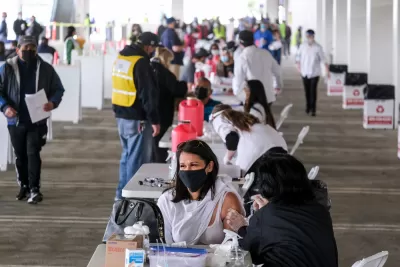Cases are surging in the U.K. despite 68% of its population being fully vaccinated. Experts say that U.K. officials should observe how Israel, with 63% of its population fully vaccinated, managed to reduce transmission after a similar surge.

The U.S., U.K., and Russia lead the world in the daily average of new coronavirus cases, with 70,000, 45,000, and 35,000, respectively, according to The New York Times global tracker on October 25, 2021. However, with 67 daily new cases per 100,000 people, the U.K. has the world's 14th highest case incidence, according to Worldometer.
"As Covid-19 cases soar again in the U.K., officials could look to a country that’s moved past a similar crisis for a possible roadmap," writes Gwen Ackerman for Bloomberg Prognosis on Oct. 19.
The search for answers in Israel may be useful, health experts say, because both countries were among the fastest in the world with their vaccination programs, yet were similarly quick to lift lockdown restrictions. And just as Israel experienced a spike in cases in June, so the U.K. is now, having just reported the biggest single daily jump in infections in three months.
Israel’s response to its renewed outbreak was to roll out an aggressive booster program, a decision that appears to have quelled the worst of the outbreak within weeks.
Ackerman acknowledges that there were other factors to consider – call it a "booster plus" strategy.
"These include the masks mandate, the ‘Green Passes’ [vaccine passport], the massive testing both with PCR testing and rapid antigen tests," stated Ran Balicer, who heads the government's coronavirus expert advisory panel, as reported by Maayan Lubell from Jerusalem on Oct. 15 for Reuters.
"But undoubtedly, the most important impactful factor in bringing down the Delta summer surge was the mass vaccination campaign with booster doses," Balicer said.
Since peaking in early September, daily infections in Israel have fallen more than 80%, with severe cases nearly halved.
Israel's average case incidence on Oct. 24 was 10 per 100,000 people, down 56% in the last two weeks, according to the Times tracker, while the U.K.'s was 67 per 100k, up 21% in the last two weeks.
Waning Immunity
Ackerman continues, citing the aforementioned Israeli coronavirus expert.
“Israel was the first country to have a mass vaccination campaign and it was the first to experience the full impact of waning immunity” and the mass susceptibility that followed, said Ran Balicer, the Tel Avi-based chairman of Israel’s national Covid-19 advisory team. Other countries that vaccinated later will go through the same thing, “unless they use the lessons learned here and consider the booster campaign,” he said.
Britain has a booster program that began in late September. It’s open to people 50 and older, and is focusing on the elderly in that age group, as well as other vulnerable people. In Israel, the rollout extended to people 12 and above within weeks of its Aug. 1 launch.
In a particularly hard-hitting article in The New York Times published Oct. 21 about Prime Minister Boris Johnson's COVID strategy that ended restrictive measures on July 19, Mark Landler and Stephen Castle look at what's gone wrong in the U.K.
At issue is the core trade off British officials made last summer: They decided they could tolerate a widely circulating virus as the price of reopening the economy, so long as only a small fraction of infected people ended up in the hospital.
That laissez-faire approach has been watched by the United States and other European countries as a possible model for how to plot a way out of the pandemic. Britons have enjoyed a return to normalcy unseen in the rest of Europe, packing nightclubs, theaters, and sports stadiums — with face masks few and far between.
Landler and Castle note the waning immunity problem as well as the lack of mitigation measures for K-12 schools.
There is also evidence that more vaccinated people are getting infected, a shift from a few weeks ago, when the bulk of infections occurred in schoolchildren, according to Professor Spector’s Zoe Covid Study. The government sent students back to school in September largely unvaccinated and without requiring them to wear face masks.
“The makeup of the infected is a mix of young, unvaccinated people and older, vaccinated people," said Tim Spector, a professor of genetic epidemiology at King’s College London who has been leading a major study of Covid-19 symptoms.
That, he said, mostly reflects the waning efficacy of the vaccines, which were rolled out earlier in Britain than in most other large countries and so are wearing off earlier. Nearly 80 percent of people 12 and older in Britain have received two shots of a vaccine, but most older people got their shots six months ago or earlier.
To compound matters, the booster program has, according to one notable critic, not gone well.
“The rollout of the boosters has been very disappointing,” said David King, a former chief scientific adviser to the government. “What the British government has done is to sit back and say, ‘We can’t control this, so let’s just let this spread.’”
And if the U.K. didn't have enough to deal with in reducing the Delta surge, a possibly more infectious off-shoot of the Delta variant has emerged that some are calling Delta Plus.
In the U.S., the booster program got off to a rocky start when Centers for Disease Control and Prevention Director Rochelle Walensky "reversed a move by agency advisers and endorsed additional doses of the Pfizer-BioNTech vaccine for health care workers, teachers and other workers at risk," reported the Times on Sept. 24. However, for people without underlying conditions who aren't front-line workers, the age bar is 65 years.
On Oct. 22, the booster program was expanded to include the other two authorized COVID-19 vaccines, Moderna and Johnson & Johnson/Janssen, with the age criteria for J&J being 18 years due to its lower vaccine efficacy.
Case incidence in the U.S., with 57.4% of its population fully vaccinated on Oct. 25, has dropped by 22% in the past two weeks to 21 per 100,000 residents, but experts note that the U.S. is often weeks behind what happens in Europe, where cases are rising.
The last word goes to Dr. Walensky, who cautioned at the White House COVID-19 Response Team briefing on Oct. 22 about relying on the vaccine alone to reduce transmission.
As you have heard me say before, we will not boost our way out of this pandemic. And no vaccine, even a boosted vaccine, provides 100 percent protection. So even after you boost, it remains important for us to remain smart about our prevention strategies while we still have over 93 percent of our counties with high or moderate community transmission.
Related in Planetizen:
- Boosters Bring Normalcy Back to Tel Aviv, October 18, 2021
- New Data from Israel Brings Good and Bad News on Pfizer Vaccine Effectiveness, July 7, 2021
- Will Israel Show Us the Way Out of the Pandemic? February 14, 2021
- England Begins Second Lockdown to Protect the National Health Service, November 8, 2020
FULL STORY: As U.K. Covid Cases Surge, Israel Offers Lesson in Boosters

Study: Maui’s Plan to Convert Vacation Rentals to Long-Term Housing Could Cause Nearly $1 Billion Economic Loss
The plan would reduce visitor accommodation by 25,% resulting in 1,900 jobs lost.

North Texas Transit Leaders Tout Benefits of TOD for Growing Region
At a summit focused on transit-oriented development, policymakers discussed how North Texas’ expanded light rail system can serve as a tool for economic growth.

Why Should We Subsidize Public Transportation?
Many public transit agencies face financial stress due to rising costs, declining fare revenue, and declining subsidies. Transit advocates must provide a strong business case for increasing public transit funding.

How to Make US Trains Faster
Changes to boarding platforms and a switch to electric trains could improve U.S. passenger rail service without the added cost of high-speed rail.

Columbia’s Revitalized ‘Loop’ Is a Hub for Local Entrepreneurs
A focus on small businesses is helping a commercial corridor in Columbia, Missouri thrive.

Invasive Insect Threatens Minnesota’s Ash Forests
The Emerald Ash Borer is a rapidly spreading invasive pest threatening Minnesota’s ash trees, and homeowners are encouraged to plant diverse replacement species, avoid moving ash firewood, and monitor for signs of infestation.
Urban Design for Planners 1: Software Tools
This six-course series explores essential urban design concepts using open source software and equips planners with the tools they need to participate fully in the urban design process.
Planning for Universal Design
Learn the tools for implementing Universal Design in planning regulations.
Ascent Environmental
Borough of Carlisle
Institute for Housing and Urban Development Studies (IHS)
City of Grandview
Harvard GSD Executive Education
Toledo-Lucas County Plan Commissions
Salt Lake City
NYU Wagner Graduate School of Public Service




























